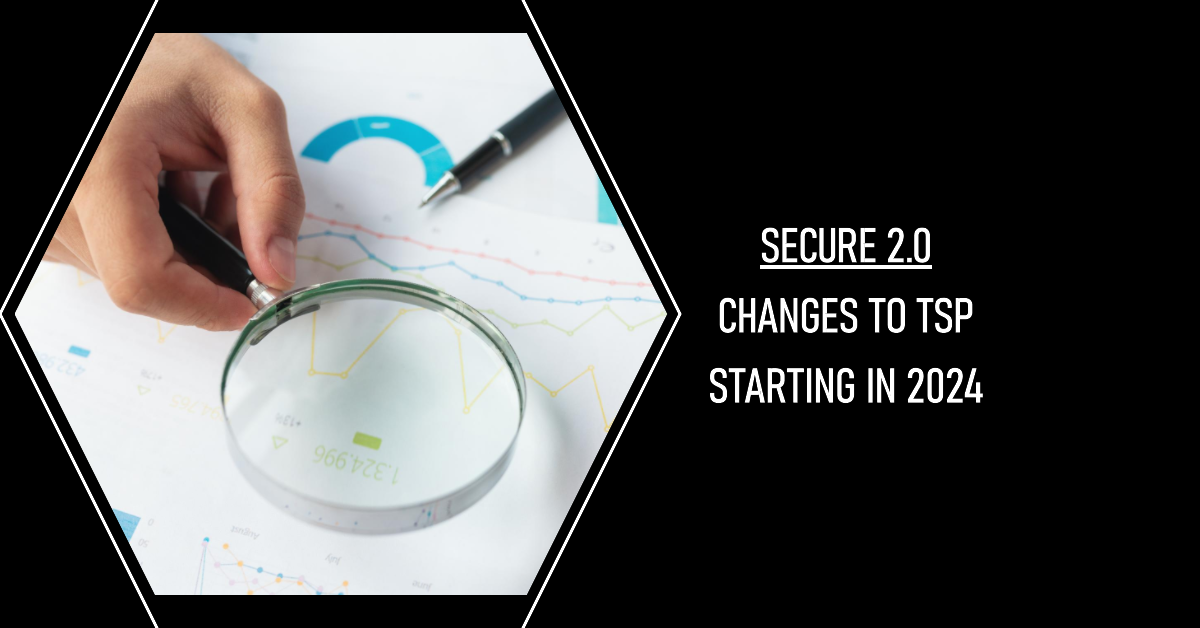SECURE 2.0 Changes to Thrift Savings Plan (TSP) Starting in January and into the Future
Amidst the dynamic landscape of retirement planning, the SECURE 2.0 Act has emerged as a pivotal legislation, ushering in significant changes to the Thrift Savings Plan (TSP) and shaping the future of retirement savings. Understanding the implications of this legislation is paramount for Federal employees and every community gearing up for retirement.
TSP has published the changes that will take effect in 2024. It was unknown if all changes from SECURE 2.0 would take effect in 2024 as there has been grace and transition periods announced to allow private employers and TSP to establish guidelines and operations. An example of this is the 2-year transition period for the new catch-up rule: TSP Participants Required to Make Roth Contributions Starting in 2024? We will cover each change and their respective time horizon.
Overview of SECURE 2.0 Act
SECURE Act 2.0 has set to improve on the original SECURE Act passed in July 2019. The Setting Every Community Up for Retirement Enhancement Act was designed to increase access to tax-advantaged accounts and to help simplify retirement plan rules. SECURE 2.0’s stated goal says that it is “to increase retirement savings, simplify and clarify retirement plan rules, and for other purposes.” There are a lot of big changes that will affect everyone’s retirement so it is important to understand how these changes can impact you.
Find more information on SECURE 2.0 – Big Changes To Retirement Plans
Changes Effective Starting 2024
Roth No Longer Subject to RMDs
Beginning in 2024, Roth balances will no longer be subject to RMDs. RMD calculations will only include your traditional balance, and only distributions from your traditional balance will count toward satisfying the RMD amount. (Learn more about recent RMD provisions.)
If you have a Roth balance in your TSP account, this means your 2024 RMD amount may be less than it would have been.
Important: Calculations for RMDs from spouse beneficiary participant accounts will still include the entire account balance, and any distribution from a spouse beneficiary participant account will still count toward satisfying the RMD.
Future Changes Effective Starting 2025 & 2026
Higher Catch-Up Limits at Age 60, 61, 62, and 63
Beginning January 1, 2025, participants age 60, 61, 62, and 63 who are eligible for catch-up contributions will have a higher catch-up limit than participants who are younger or older. For these participants, the IRS catch-up contribution limit increases to the greater of $10,000 (indexed to inflation) or 150% of the regular catch-up limit.
Catch-Up Contributions Must Be Roth If Prior Year’s Income Over Threshold
Beginning in 2026, eligible catch-up contributions must be Roth contributions if your income is above a certain threshold. The IRS wage threshold will be adjusted for inflation and announced by the IRS each year. (When this law passed in 2022, the original wage threshold was set at $145,000 for 2023 wages.) In general, the wages that determine whether this rule applies to you are equal to Medicare wages listed in box 5 of your W-2(s).
Beginning in 2026, if this provision applies to you and your contribution election includes savings to your traditional TSP balance, your contributions will change automatically to all Roth TSP contributions once you meet the annual elective deferral limit (or annual additions limit if making traditional contributions from tax-exempt pay in a combat zone).
Changes Effective Now (Jan 1st 2023)
Required Minimum Distribution Age Increases
SECURE 2.0 increases the age you must begin taking RMDs from your TSP account. The start age for RMDs increased from 72 to 73 starting on January 1, 2023. The start age will further increase to 75 on January 1, 2033.
Reduced Tax Penalty on Missed RMDs
If you don’t take the full amount of your RMD in a given year, you may be subject to an IRS penalty tax (excise tax). SECURE 2.0 reduced that penalty from 50% to 25% of the amount not paid to you on time. It further reduces the penalty to 10% of that amount if you meet the conditions of section 4974(e) of the Internal Revenue Code, and the RMD is timely corrected within two years.
Exemption From 10% Early Withdrawal Penalty for Public Safety Employees
If you’re a qualified public safety employee as defined in 29 U.S.C. 72(t)(B) of the Internal Revenue Code, your distributions will not be subject to the 10% early withdrawal penalty if you’ve separated from service and have 25 years of service under the Plan, even if you haven’t yet reached age 50 when you separate. Previously, the requirement was that you must have retired after age 50 to take advantage of this rule. Now, the rule expands to those who have separated from service with at least 25 years of service regardless if they have reached age 50. (See more about TSP withdrawal rules for public safety employees.)
Substantially Equal Periodic Payments
When a participant meets the requirements for an exception to the 10% early withdrawal penalty by receiving substantially equal periodic payments, the exception will continue to apply in the case of a rollover of the account (if payments continue) or an annuity purchase that satisfies the required minimum distribution rules.
Roth Funds to SIMPLE and SEP IRAs
SECURE 2.0 allows Roth contributions to SIMPLE (Savings Incentive Match Plan for Employees) IRAs and SEPs (simplified employee pension plans). This means that you can roll over money from your Roth TSP balance to these types of plans.
Reach Out to Us!
If you have additional federal benefit questions, reach out to our team of CERTIFIED FINANCIAL PLANNER™ (CFP®) and Chartered Federal Employee Benefits Consultants (ChFEBC℠). At PlanWell, we focus on retirement planning for federal employees and are a financial advisor for federal employees. Learn more about our process designed for the career federal employee.
Preparing for a federal retirement? Check out our scheduled federal retirement workshops. Sign up for our no-cost federal retirement webinars to learn more and register. Make sure to plan ahead and reserve your seat for our FERS webinar, held every three weeks. Interested in having PlanWell host a federal retirement seminar for your agency? Reach out, and we can collaborate with HR to arrange an on-site FERS seminar.
Want to fast-track your federal retirement plan? Skip the FERS webinar and start a one-on-one conversation with a ChFEBC today. You can schedule a one-on-one meeting with our team.










